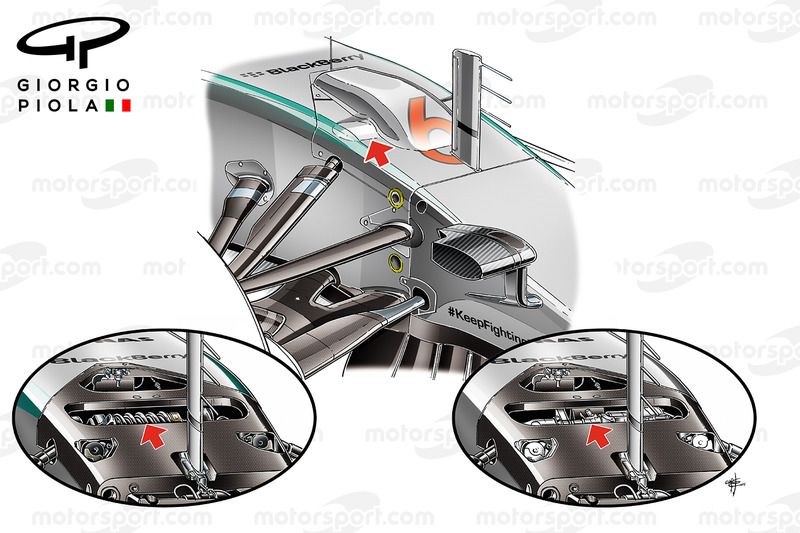Lewis Hamilton’s victory in Formula 1’s British Grand Prix proved that Mercedes finally appears to be properly back in the game.
For where George Russell’s triumph in Austria owed much to the race leaders crashing out, Hamilton’s Silverstone win was one based on pure pace – where it could be argued the W15 was the fastest car.
Mercedes has made great progress this year and has unlocked significant gains from its car – which are the result of it finally understanding what is needed to make a current ground effect machine fast.
As team boss Toto Wolff said: “It clicked. Suddenly everything that didn’t make sense made sense. And the development direction is or the results of the development directions in back in the old days. We are finding performance, we’re putting it on the car, and it translates into lap time. And that wasn’t the case for the last two years.”
But the biggest breakthrough for Mercedes was not it suddenly unleashing a new aero component that produced a ton more downforce.
Instead, according to Wolff, it was down to the way that the team under technical director James Allison has been able to harness its package to bring a great car balance – which has helped put it in a happy place for both Hamilton and Russell.
Wolff added: “There was a moment where, led by James, suddenly the data made sense. The way we made it, the way we balanced the car and how we could bring it in a better sweet spot — that was the main thing. It wasn’t a miracle front wing. It was more the balance that we achieved.”
This reference to balance is interesting because it can often be the result of progress under the skin with mechanical aspects, like suspension and springs.
And whether it is a simple coincidence, or there is more to it, a tweak to a vanity panel on the nose of the W15 that first appeared at the Austrian Grand Prix may have offered a clue about a potential damper change that could have contributed to its progress.

Mercedes W15 technical detail
Photo by: Giorgio Piola
The vanity panel (pictured above) features a new bulge, which the team claims is all related to cooling – and is a means to increase the passage of cool air into the cockpit, albeit without the forward-facing inlet that the team has used before.
However, the idea that the new bulge is wholly related to cooling seems to be in contrast to how the air would move through that portion of the car. Usually, you would expect driver cooling to be piped to a specific region.
This eliminates some of the messy flow conditions that would occur, which is especially problematic when we consider how many different components are housed in that region, some of which are suspension elements and are moving around.
Furthermore, it seems quite weird to have increased the bulge to potentially offer more airflow but at the same time that a forward vent is closed off to the outside air.
Beyond that, the team did not submit the vanity panel as being altered in the car presentation document at the Austrian Grand Prix either — which somewhat rules it out as being updated from an aerodynamic standpoint.
Fast forward to the British GP and the retention of this new chassis bulge, in cold conditions that aren’t conducive to the drivers requiring additional cooling, fuelled the idea that there is more to the change than meets the eye – and that the real answer lies in what has been altered beneath the panel.
Indeed, while the team is not confirming it, a detailed study of the components in this area points to a revised damper layout that requires more space. Such a change could be critical to helping Mercedes add further stability to its aero platform and, once again, nail that balance that it has been pursuing for so long.
Mercedes certainly has precedent for adding a bulge in this area of the car when it has made suspension changes in the past.

Mercedes W06 hydraulic parts, front suspension
Photo by: Giorgio Piola
Back in 2016, this was a dual-purpose test, as the team experimented with a new arrangement on the W06 for the following season that included both an ‘S’ duct arrangement and a revised heave damper.
It was during that time period that Mercedes was widely acknowledged to have had the best handle on suspension kinematics and their influence over the aerodynamic platform of the entire grid.
For example, Mercedes had one of the most advanced versions of the front-to-rear interconnected (FRIC) suspension systems, before the concept was banned. It was this that set the foundation for its highly-successful hydraulic suspension systems that followed.
A switch to more traditional spring and damper arrangements with the current cars has undoubtedly eroded some of the assistance that Mercedes and other teams lent on before the regulation changes.
It now has a Belleville Spring arrangement, which is almost unilaterally agreed as being the best route taken for the design of the heave damper, and Mercedes uses the method as a means to help control the vertical displacement of the chassis.
It is this component that is the likely candidate for upgrade or replacement that has led to the use of the bulging vanity panel.

Mercedes W15 technical detail
Photo by: Giorgio Piola
A modified heave element and/or a change in the position of the component would also tie in with some of the aerodynamic changes that the team has made recently. Tweaks here will go hand-in-hand to deliver a more stable platform, something which the team has struggled with during this regulatory era.
The W15 also now appears more responsive over a range of conditions and downforce levels, whereas updates appearing on the car in the past seem to have worked well at one circuit but fallen short of their target elsewhere.








